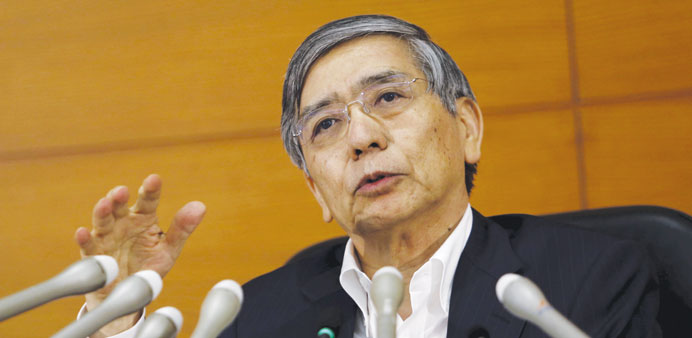Bank of Japan governor Haruhiko Kuroda speaks during a news conference at the BoJ headquarters in Tokyo. The BoJ has pumped ¥180tn into the economy since adopting quantitative and qualitative easing programme and each month gobbles up government bonds equivalent to about 1% of Japan’s GDP.
Reuters/Tokyo
Sources say the Bank of Japan has been quietly brainstorming the idea of overhauling its massive monetary stimulus programme over time, casting doubt on officials’ confident assertions that it can keep buying up government bonds for several more years.
Sources familiar with the BoJ’s thinking say stepping up its ¥80tn ($665bn) per year asset buying remains its go-to option if deflationary pressures persist, given a limited arsenal of obvious policy alternatives.
But they say the central bank isn’t ruling out breaking with the money-printing programme over the longer term, as it has had little success in accelerating inflation toward its 2% target since it began in April 2013.
Senior BoJ officials have been involved in preliminary talks discussing the longer-term options, the sources said.
“If the medicine isn’t working, you wonder whether it makes sense to keep prescribing more,” one of them said on condition of anonymity.
Another source quoted a senior BoJ official as saying that if the so-called quantitative and qualitative easing (QQE) programme fails to accelerate inflation for too long, a revamp of the framework may become an option.
“QQE is not a programme intended to last another five, 10 years,” said a former BoJ policymaker with knowledge of current monetary policy deliberations. The BoJ has pumped ¥180tn into the economy since adopting QQE and each month gobbles up government bonds equivalent to about 1% of Japan’s GDP.
While the stimulus has boosted exporters’ profits by weakening the yen, its broader impact has been weak as firms remain wary of increasing wages and investment.
Inflation has ground to a halt on falling oil costs and soft consumption, rekindling market expectations the BoJ might step up easing as early as next month.
But with borrowing costs near zero, some BoJ officials doubt whether expanding QQE would help the economy much and some worry they might eventually run out of sellers if they accelerate the programme.
The BoJ already holds about a quarter of Japanese government bonds (JGB) in the market, and that would rise to nearly 40% by the end of 2016 at the current pace of buying.
BoJ technocrats say they can keep buying as long as they offer high prices, but BoJ board member Takehiro Sato, a former bond analyst, has argued that there are limits because financial institutions need a certain level of JGBs for collateral.
The International Monetary Fund agrees.
“Given the pace of the BoJ’s purchases under the QQE programme that is under way ... you could run out of willing sellers of JGBs by the end of 2017,” said Kalpana Kochhar, the IMF’s mission chief for Japan.
That would not just make the bond market dysfunctional, it would also prevent the bank from hitting its monetary base target.
For now, there is no consensus within the BoJ on what any overhaul to the programme might look like. Many policymakers still cling to hope that inflation will rise enough to allow them to consider phasing out QQE around 2017.
But with a sales tax hike looming that year, many analysts doubt the BoJ can withdraw stimulus so soon. If the BoJ bumps into trouble buying JGBs, some analysts say it could abandon the 0.1% interest the central bank pays on reserves the financial institutions park in BoJ accounts, or even charge a fee for them. That might particularly hurt regional banks, which are already struggling with thin margins on bond investments.
“The BoJ can combine this step with an increase of risky asset purchases and call it a new version of QQE,” said Ryutaro Kono, chief Japan economist at BNP Paribas, who was once considered a candidate to fill a BoJ board vacancy.
“That would effectively mean shifting the BoJ’s target to interest rates from the volume of money.”
BoJ Governor Haruhiko Kuroda has ruled out the idea as it would make it hard to achieve the BoJ’s base money target by discouraging banks from depositing funds with it.
But he also said that in Europe, negative interest rates had had essentially the same effect as QQE in pushing down yields across the curve.
The IMF’s Kochhar said cutting the 0.1% interest could be one way to “get the money out the door”. “The BoJ has told us while nothing is ruled out, they would watch carefully the European Central Bank’s experience.”

